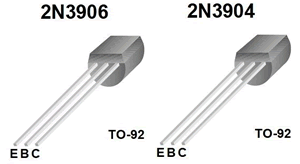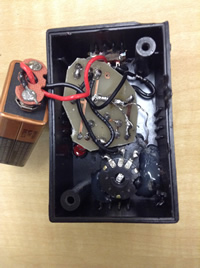 Project 4. Digital (Transistor-Based) Logic Gates. For this submission you are asked to,
Project 4. Digital (Transistor-Based) Logic Gates. For this submission you are asked to,
 Merge the Word document, InsideGates, into your ER on the first page after Project 3, retaining the landscape orientation of the document. Be sure to format all the requirements below into this single page, scaling as necessary, but retaining maximum readability.
Merge the Word document, InsideGates, into your ER on the first page after Project 3, retaining the landscape orientation of the document. Be sure to format all the requirements below into this single page, scaling as necessary, but retaining maximum readability.- Ensure your ER header and footer elements run through the page, adjusting the tab stops as necessary to accommodate landscape orientation.
- Set the title to your Heading Style.
- Adjust the cell shading to be consistent with your previous preference.
- Complete the Fritzing Schematic Name, Symbol, and Truth Table for each of the remaining three transistor-based gates. Do NOT make any mistakes; it's too important!
- Be sure to update your Table of Contents prior to submission.
Project 3. 3D Christmas Tree
 Under appropriate Heading 2-styled subheadings (Purpose, Reference, Procedure, Media and Conclusion) your ER submission for this Project
will include the following.
Under appropriate Heading 2-styled subheadings (Purpose, Reference, Procedure, Media and Conclusion) your ER submission for this Project
will include the following.
- A description of your project's prototype as introduced in Project 4.1 on page 42 in our workbook. In it, you will explain the basic principle behind the Analog Oscillator and the role it plays in the circuit. Your decription will be supported by a 3", right-aligned, well-composed, bordered, photo.
- A paragraph describing your kit (include a full Parts Table, right-aligned within the Procedure Section, consistent with your previous table formats and my previous email Feedback comments)
- The schematic of The 3D Christmas Tree circuit below. Since it
is quite wide, you should center-align the graphic on the page.
- Photos of your 3D Christmas Tree accompanied by a link to a video of your tree in action.
- Update your ToC.
Attach your ER to an email to
handin with the Subject: The 3D Christmas Tree by
the requested deadine.
Project 2. The Automatic Night Light

 This is a major project in that after a successful prototype build on your breadboard you will assemble a permanent version by soldering the components to the custom printed circuit board in your kit. After that, you will mount the unit in some form of permanent housing. Since you will be submitting a full ER entry for this project, you will document the build process with photos and video as it evolves. (Another objective of this project is to start you thinking about your personal ISP project that will require you to research/envision a circuit to build, assemble, and present)
This is a major project in that after a successful prototype build on your breadboard you will assemble a permanent version by soldering the components to the custom printed circuit board in your kit. After that, you will mount the unit in some form of permanent housing. Since you will be submitting a full ER entry for this project, you will document the build process with photos and video as it evolves. (Another objective of this project is to start you thinking about your personal ISP project that will require you to research/envision a circuit to build, assemble, and present)
Prototype.
- Be patient and assemble a quality prototype of Circuit 4.1. Take a high detail photo for your ER Summary.
- Consider the Test Point shown in Red below. With a DMM, obtain and record voltage readings for the various settings described below.
- Set the pot to 0 Ω (wiper C all the way to A) and under fairly good light, measure and record the voltage at the Test Point.
- Now, obscure the LDR completely with a heavy dark covering and take another voltage reading. Explain the difference.
- Adjust your pot to 50k Ω (wiper C halfway between A and B) and repeat the previous two measurements. Record and discuss the results.
- Finally, set your pot to its full 100k Ω setting (wiper C all the way to B), and repeat the two measurements one last time. Record and explain your results.

ER. Your writeup for this Project will include,
- Purpose, Reference, Procedure, Media and Conclusion subsections (Heading 3 Style) with appropriate content.
- Include a background-shaded Parts List Table, right-aligned within your Procedure subsection.
- Incorporate the measurements taken earlier with your prototype into a response to Question 1 on page 38 of our Workbook.
- Fritzing schematic view of Circuit 4.1. You may use the one below as long as it is properly sized.
- Clear photos of front and back of your soldered PCB.
- Photos and a video of the complete circuit development process and result in action.
Address, but do not remove, the concerns expressed
in ALL my comments embedded in your ER.docx from the last submission.
Submit your ER.docx as
an attachment to an email to handin with the Subject Line: The Automatic Night Light
Project 1. LED Brightness
One of the most important skills an Engineer must have is the ability to communicate, both in spoken word and in written form. Developing this skill takes much practice and this is precisely why the Engineering Report plays such a crucial role in our program (and your mark!)
For your first Engineering Report (ER) submission, you are to document Circuit 1.7. LED Brightness with the use of the potentiometer as the variable resistor.
You are required to be familiar with the Guide for Technical Writing and through practice and regular editing your sentence structure will improve. Poor grammar and spelling skills detract greatly from your presentation.
Task.
- Create the Word document, ER.docx that includes the title page, Table of Contents and headers and footers as discussed in class.
- Each Project writeup starts on a new page.
- For this project subsections must include Reference (Include a hyperlink containing the URL of this project description), Theory (include a discussion of the potentiometer), Procedure (discuss the prototype sequence; retype Questions 1, 2 and 3, and provide answers to each; both well-formatted)
- Develop your own Fritzing breadboard and schematic images for inclusion in your submission and store them in your images folder. Include them in a Media subsection together with appropriately-sized,composed, and formatted photos.
- Create a short (1 min) video of your circuit with accompanying explanations and annotations of the components. Upload to YouTube and include a link in the Media section. Review some of the best student videos on our home page to get an idea of what is expected.
- Provide a Conclusion. A single, well thought out paragraph is appropriate.
- Update your Table of Contents.
- Attach your Engineering Report to an
email to handin with the Subject: LED Brightness by
the required due date.
Your text should be developed in accordance with the recommendations for Technical Writing.
 Merge the Word document, InsideGates, into your ER on the first page after Project 3, retaining the landscape orientation of the document. Be sure to format all the requirements below into this single page, scaling as necessary, but retaining maximum readability.
Merge the Word document, InsideGates, into your ER on the first page after Project 3, retaining the landscape orientation of the document. Be sure to format all the requirements below into this single page, scaling as necessary, but retaining maximum readability.


